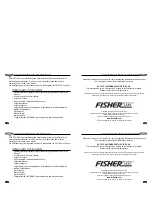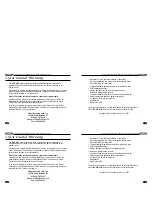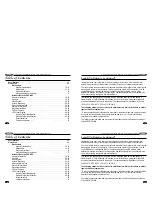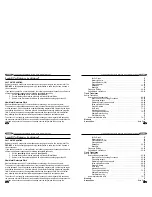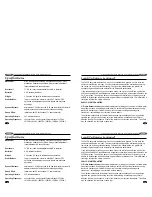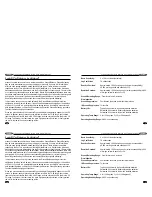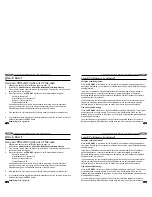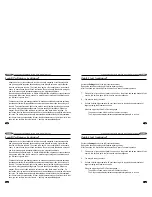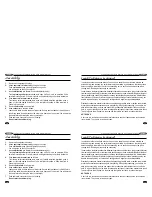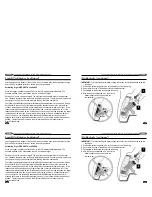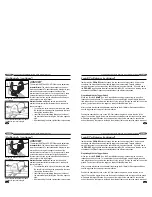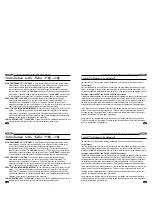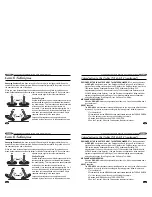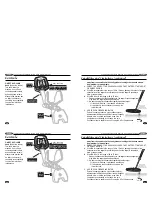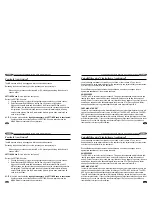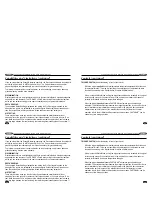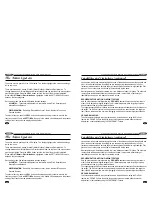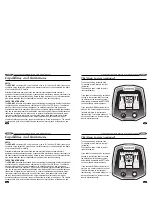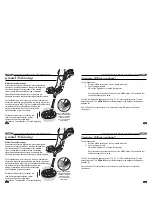
33
Comprehensive Operating Manual & Guide to Metal Detecting
PRO-ARC
22
PRO-ARC
Comprehensive Operating Manual & Guide to Metal Detecting
11
Assembly (continued)
8.
Tighten knurled cap nut by hand to secure cable connection to housing. Use minimal
finger pressure to start thread. Do not force threads. Nut may not completely cover
all threads when fully engaged.
9.
Adjust to your height:
Hold detector, standing up, with your arm in the armrest. Place searchcoil flat on the
ground with back edge of coil 6” in front of your toes. Click pin on lower rod into nearest
hole. Firmly tighten bottom locking collar to secure lower stem.
10. Attach cable to top of rod with upper Velcro strip.
11. Tighten up coil knob to keep searchcoil from flopping.
12. Insert batteries.
4 batteries are all installed the same way -- positive terminals pointed upward.
After establishing a comfortable length, firmly tighten the locking collars on the rods to
prevent the tubes from rattling. Rotate the collars a full 270° to engage and lock in place.
If you are unable to rotate a full 270°, use gloves for a better grip.
If the searchcoil appears crooked with respect to the pole, loosen both locking collars and
re-adjust. Hold each of the lower poles in the counterclockwise position as you tighten
the locking collars.
70
Search Techniques (continued)
include deeply buried objects, little bits and pieces of rusty iron and corroded foil. These items
can be detected, but are difficult to pinpoint due to their depth and small size. When you dig
and find nothing, it may seem like the machine is beeping at nothing even though there is
actually something there. The best solution is usually to reduce sensitivity.
If searching a very trashy area and unwanted signals are a problem, search with the searchcoil 2
inches away from the ground. Trash objects very close to the searchcoil will sometimes not be
completely eliminated, even when the discrimination setting should have eliminated the target.
Metal detectors are designed to see one metal object at a time. Where there are two iron
objects near each other, the detector can be fooled into thinking that the gap between them is
nonferrous metal. This is a common condition where a wooden building has burned or been
torn down, and the site is littered with nails. A signal from a nonferrous metal object such as a
coin will usually be repeatable, whereas a false positive signal resulting from multiple or oddly
shaped iron objects will seem to wander around and even to vanish.
GROUND MINERALS
Conductive mineral salts usually produce broad signals which will not be mistaken for a
metallic object. Common causes are concentrations of mineral fertilizer, spots where
evaporation has concentrated naturally occurring mineral salts residue from de-icing salts and
urine from livestock. Unless dry, “cow pies” can sound off like they are metal. Ocean beaches
have salt water - that subject is discussed toward the end of the manual.
33
Comprehensive Operating Manual & Guide to Metal Detecting
PRO-ARC
22
PRO-ARC
Comprehensive Operating Manual & Guide to Metal Detecting
11
Assembly (continued)
8.
Tighten knurled cap nut by hand to secure cable connection to housing. Use minimal
finger pressure to start thread. Do not force threads. Nut may not completely cover
all threads when fully engaged.
9.
Adjust to your height:
Hold detector, standing up, with your arm in the armrest. Place searchcoil flat on the
ground with back edge of coil 6” in front of your toes. Click pin on lower rod into nearest
hole. Firmly tighten bottom locking collar to secure lower stem.
10. Attach cable to top of rod with upper Velcro strip.
11. Tighten up coil knob to keep searchcoil from flopping.
12. Insert batteries.
4 batteries are all installed the same way -- positive terminals pointed upward.
After establishing a comfortable length, firmly tighten the locking collars on the rods to
prevent the tubes from rattling. Rotate the collars a full 270° to engage and lock in place.
If you are unable to rotate a full 270°, use gloves for a better grip.
If the searchcoil appears crooked with respect to the pole, loosen both locking collars and
re-adjust. Hold each of the lower poles in the counterclockwise position as you tighten
the locking collars.
70
Search Techniques (continued)
include deeply buried objects, little bits and pieces of rusty iron and corroded foil. These items
can be detected, but are difficult to pinpoint due to their depth and small size. When you dig
and find nothing, it may seem like the machine is beeping at nothing even though there is
actually something there. The best solution is usually to reduce sensitivity.
If searching a very trashy area and unwanted signals are a problem, search with the searchcoil 2
inches away from the ground. Trash objects very close to the searchcoil will sometimes not be
completely eliminated, even when the discrimination setting should have eliminated the target.
Metal detectors are designed to see one metal object at a time. Where there are two iron
objects near each other, the detector can be fooled into thinking that the gap between them is
nonferrous metal. This is a common condition where a wooden building has burned or been
torn down, and the site is littered with nails. A signal from a nonferrous metal object such as a
coin will usually be repeatable, whereas a false positive signal resulting from multiple or oddly
shaped iron objects will seem to wander around and even to vanish.
GROUND MINERALS
Conductive mineral salts usually produce broad signals which will not be mistaken for a
metallic object. Common causes are concentrations of mineral fertilizer, spots where
evaporation has concentrated naturally occurring mineral salts residue from de-icing salts and
urine from livestock. Unless dry, “cow pies” can sound off like they are metal. Ocean beaches
have salt water - that subject is discussed toward the end of the manual.


